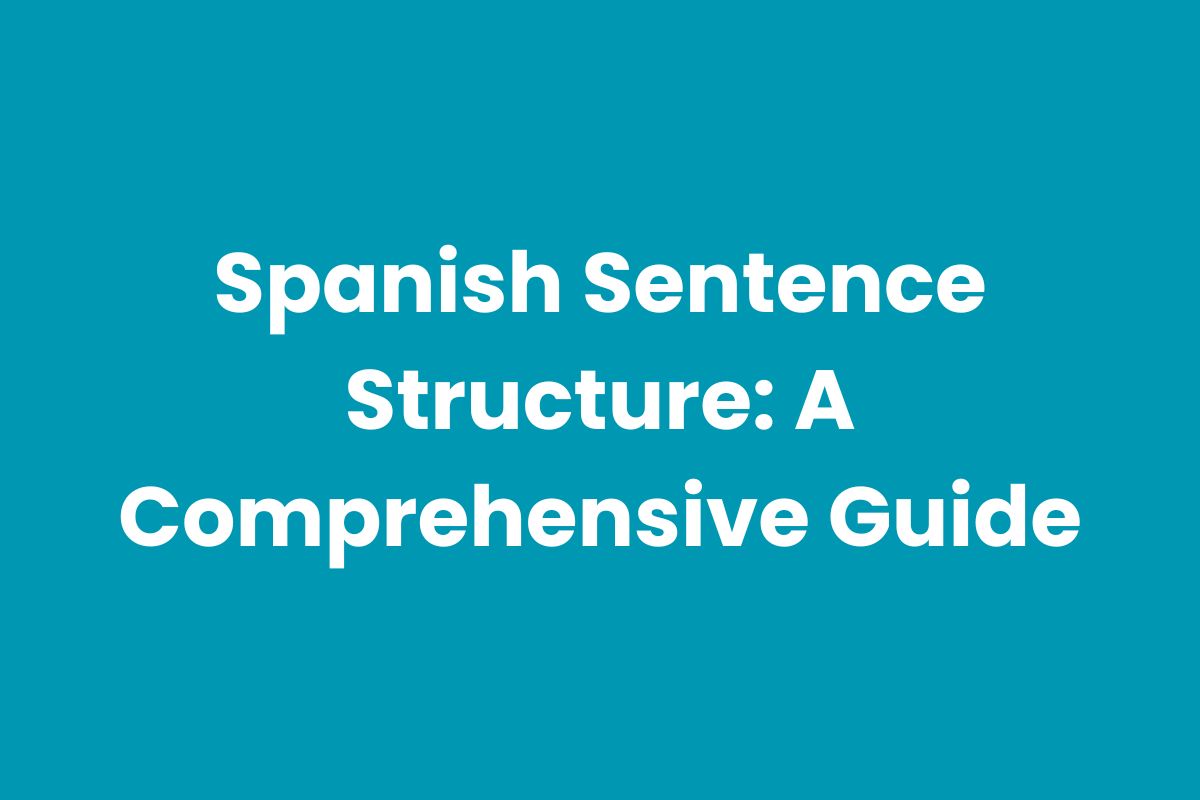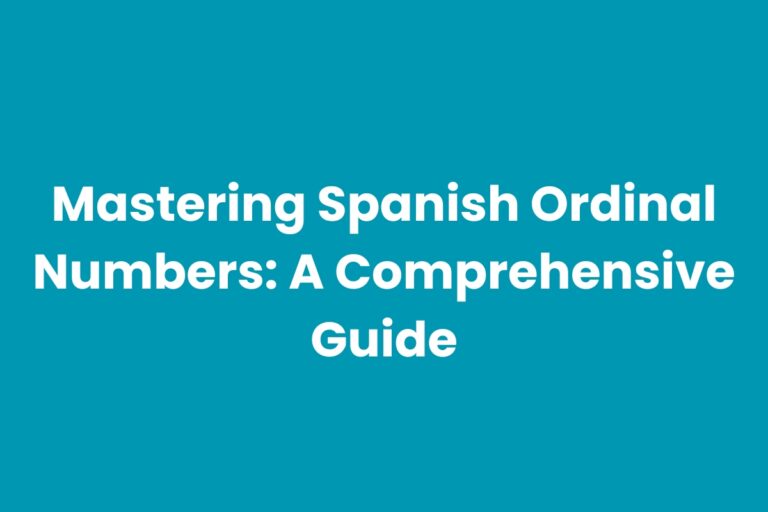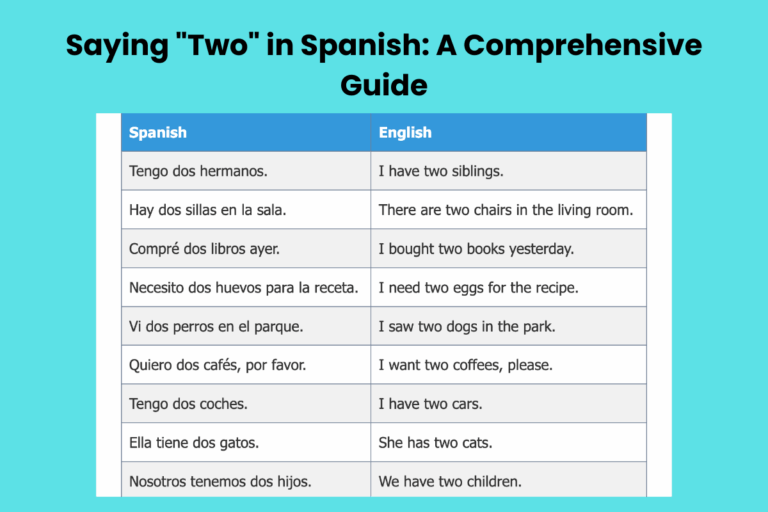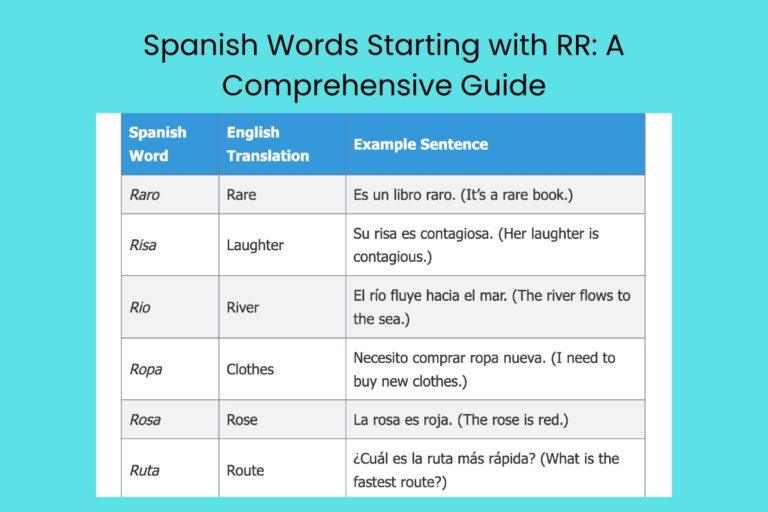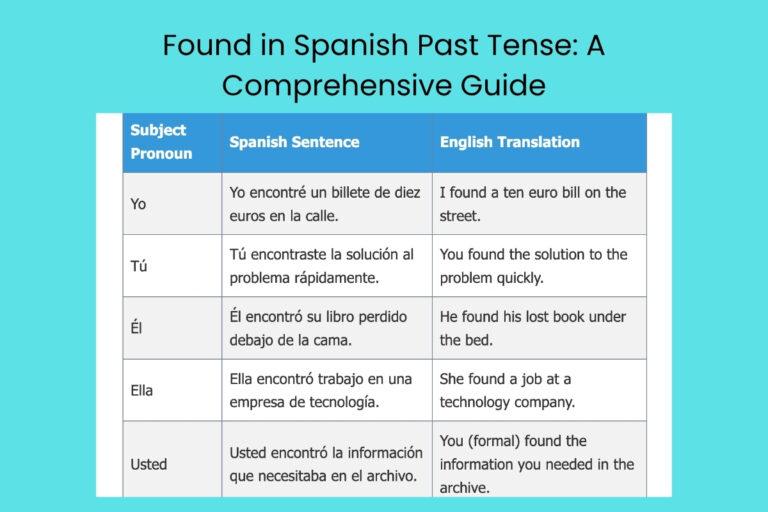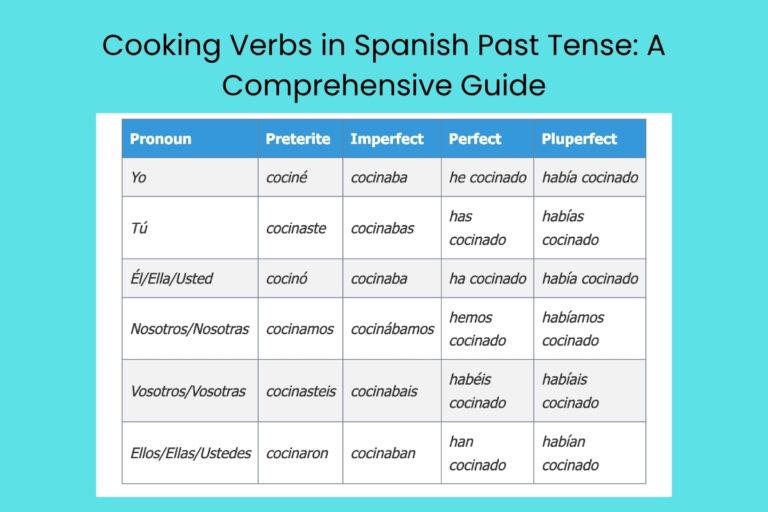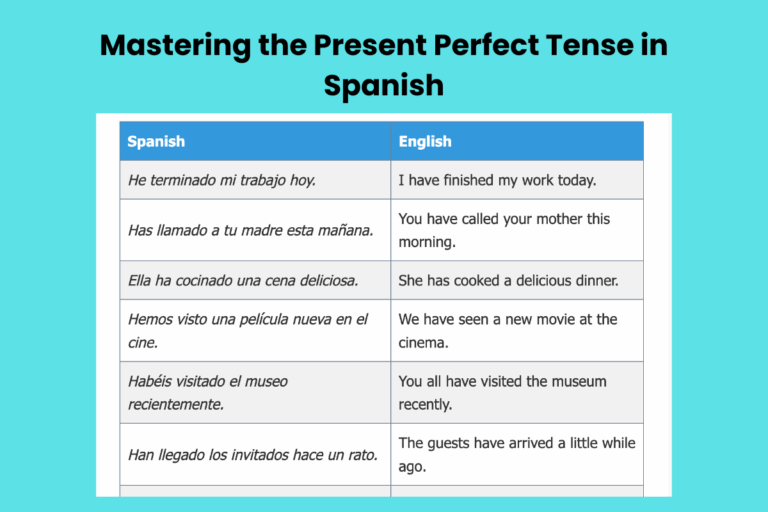Spanish Sentence Structure: A Comprehensive Guide
Understanding Spanish sentence structure is crucial for anyone learning the language. Unlike English, Spanish offers more flexibility in word order, allowing for nuanced expression and emphasis.
This guide will provide a comprehensive overview of Spanish sentence structure, covering its basic components, various sentence types, common errors, and advanced topics. Whether you’re a beginner or an advanced learner, this article will equip you with the knowledge and skills to construct grammatically correct and stylistically effective Spanish sentences.
Table of Contents
- Introduction
- Definition of Spanish Sentence Structure
- Structural Breakdown
- Types of Sentences
- Examples of Spanish Sentences
- Usage Rules
- Common Mistakes
- Practice Exercises
- Advanced Topics
- Frequently Asked Questions
- Conclusion
Definition of Spanish Sentence Structure
Spanish sentence structure, at its core, refers to the arrangement of words and phrases to form grammatically correct and meaningful sentences in the Spanish language. Unlike English, which generally follows a rigid Subject-Verb-Object (SVO) structure, Spanish offers greater flexibility, often allowing for variations in word order to emphasize different elements or to create a more natural-sounding sentence.
This flexibility, however, is governed by specific rules and conventions.
The basic components of a Spanish sentence include the subject (sujeto), which performs the action; the verb (verbo), which expresses the action or state of being; and the object (objeto), which receives the action. Other elements, such as adjectives (adjetivos), adverbs (adverbios), and prepositional phrases (frases preposicionales), add detail and context to the sentence. Understanding how these elements interact is essential for mastering Spanish sentence construction.
Spanish sentence structure can be classified based on function and complexity. Functionally, sentences can be declarative (statements), interrogative (questions), imperative (commands), or exclamatory (expressions of emotion).
In terms of complexity, sentences can be simple (one independent clause), compound (two or more independent clauses), or complex (one independent clause and one or more dependent clauses). Each type follows specific rules and patterns that must be understood for effective communication.
Structural Breakdown
A typical Spanish sentence comprises several key components, each playing a distinct role in conveying meaning. Understanding these components and their interactions is essential for constructing grammatically correct and nuanced sentences.
Subject
The subject of a Spanish sentence is the person, place, or thing that performs the action of the verb. Unlike English, Spanish often allows for the omission of the subject pronoun (yo, tú, él, ella, nosotros, vosotros, ellos, ellas) because the verb conjugation typically indicates who is performing the action. However, the subject can also be a noun or a noun phrase.
For example, in the sentence “Hablo español” (I speak Spanish), the subject pronoun “yo” (I) is omitted, but it is understood from the verb conjugation “hablo.” In contrast, “El profesor habla español” (The professor speaks Spanish) uses the noun phrase “el profesor” as the subject.
Verb
The verb is the most crucial element of a Spanish sentence, as it expresses the action, state of being, or occurrence. Spanish verbs are highly inflected, meaning they change form to indicate tense, mood, person, and number.
Mastering verb conjugations is essential for constructing grammatically correct sentences.
For example, the verb “hablar” (to speak) has different forms depending on the subject pronoun. “Yo hablo” (I speak), “Tú hablas” (You speak), “Él/Ella habla” (He/She speaks), and so on. The verb must agree in number and person with the subject of the sentence.
Object
The object of a Spanish sentence receives the action of the verb. There are two types of objects: direct objects (objetos directos) and indirect objects (objetos indirectos). The direct object receives the direct action of the verb, while the indirect object receives the indirect action.
For example, in the sentence “Yo escribo una carta” (I write a letter), “una carta” (a letter) is the direct object. In the sentence “Yo doy la carta a María” (I give the letter to Maria), “la carta” (the letter) is the direct object, and “a María” (to Maria) is the indirect object.
Adjectives and Adverbs
Adjectives modify nouns, providing descriptive information about them. In Spanish, adjectives typically follow the noun they modify and must agree in gender and number with the noun.
Adverbs modify verbs, adjectives, or other adverbs, providing information about how, when, where, or to what extent something is done.
For example, in the sentence “La casa blanca” (The white house), “blanca” (white) is an adjective that modifies the noun “casa” (house). In the sentence “Ella habla rápidamente” (She speaks quickly), “rápidamente” (quickly) is an adverb that modifies the verb “habla” (speaks).
Types of Sentences
Spanish sentences can be categorized into different types based on their function and structure. Understanding these types is crucial for effective communication and comprehension.
Declarative Sentences
Declarative sentences make statements or express facts. They are the most common type of sentence and typically follow a subject-verb-object order, although variations are possible in Spanish.
The purpose of a declarative sentence is to convey information.
Examples include: “El sol brilla” (The sun shines), “Yo estudio español” (I study Spanish), and “María es profesora” (Maria is a teacher).
Interrogative Sentences
Interrogative sentences ask questions. In Spanish, questions can be formed by inverting the subject and verb or by adding question words such as “¿qué?” (what?), “¿quién?” (who?), “¿dónde?” (where?), “¿cuándo?” (when?), “¿por qué?” (why?), and “¿cómo?” (how?). Interrogative sentences always begin and end with question marks (¿?).
Examples include: “¿Hablas español?” (Do you speak Spanish?), “¿Qué hora es?” (What time is it?), and “¿Dónde vives?” (Where do you live?).
Imperative Sentences
Imperative sentences give commands or make requests. The subject is usually implied, and the verb is conjugated in the imperative mood.
Imperative sentences are often used to give instructions or express orders.
Examples include: “Habla más lento” (Speak slower), “Come tu comida” (Eat your food), and “Escribe tu nombre” (Write your name).
Exclamatory Sentences
Exclamatory sentences express strong emotions or feelings. They often begin with exclamatory words such as “¡qué!” (how/what!) or “¡cuánto/a!” (how much!). Exclamatory sentences always begin and end with exclamation marks (¡!).
Examples include: “¡Qué hermoso día!” (What a beautiful day!), “¡Cuánto me alegro!” (How happy I am!), and “¡Qué sorpresa!” (What a surprise!).
Compound and Complex Sentences
Compound sentences consist of two or more independent clauses joined by coordinating conjunctions such as “y” (and), “o” (or), “pero” (but), or “porque” (because). Complex sentences consist of one independent clause and one or more dependent clauses, which are introduced by subordinating conjunctions such as “que” (that), “si” (if), “cuando” (when), or “aunque” (although).
A compound sentence example: “Estudio español y leo libros” (I study Spanish and I read books). A complex sentence example: “Estudio español porque quiero viajar” (I study Spanish because I want to travel).
Examples of Spanish Sentences
To further illustrate the concepts discussed, here are several examples of Spanish sentences categorized by type. These examples demonstrate the flexibility and nuances of Spanish sentence structure.
Declarative Sentence Examples
Declarative sentences are the most straightforward and commonly used. They simply state a fact or express an opinion.
The table below provides a range of declarative sentences with their English translations.
| Spanish Sentence | English Translation |
|---|---|
| El cielo es azul. | The sky is blue. |
| Yo vivo en Madrid. | I live in Madrid. |
| Ella trabaja en un banco. | She works in a bank. |
| Nosotros comemos pizza. | We eat pizza. |
| Ellos estudian medicina. | They study medicine. |
| El libro es interesante. | The book is interesting. |
| La película es divertida. | The movie is fun. |
| El café está caliente. | The coffee is hot. |
| El perro ladra fuerte. | The dog barks loudly. |
| La casa es grande. | The house is big. |
| El coche es rápido. | The car is fast. |
| La ciudad es ruidosa. | The city is noisy. |
| El examen es difícil. | The exam is difficult. |
| La lección es fácil. | The lesson is easy. |
| El tiempo es bueno. | The weather is good. |
| La música es hermosa. | The music is beautiful. |
| El restaurante es caro. | The restaurant is expensive. |
| La tienda está cerrada. | The store is closed. |
| El tren llega tarde. | The train arrives late. |
| La fiesta es divertida. | The party is fun. |
| El jardín es verde. | The garden is green. |
| La playa es tranquila. | The beach is peaceful. |
| El agua está fría. | The water is cold. |
| La comida es deliciosa. | The food is delicious. |
| El trabajo es importante. | The job is important. |
| La salud es valiosa. | Health is valuable. |
Interrogative Sentence Examples
Interrogative sentences are used to ask questions. They can be direct or indirect and often involve question words.
The table below shows a variety of interrogative sentences.
| Spanish Sentence | English Translation |
|---|---|
| ¿Cómo estás? | How are you? |
| ¿Qué haces? | What are you doing? |
| ¿Dónde vives? | Where do you live? |
| ¿Cuándo llegas? | When are you arriving? |
| ¿Por qué lloras? | Why are you crying? |
| ¿Quién eres? | Who are you? |
| ¿Tienes hermanos? | Do you have siblings? |
| ¿Estudias español? | Do you study Spanish? |
| ¿Trabajas aquí? | Do you work here? |
| ¿Comes carne? | Do you eat meat? |
| ¿Bebes café? | Do you drink coffee? |
| ¿Lees libros? | Do you read books? |
| ¿Escuchas música? | Do you listen to music? |
| ¿Ves la televisión? | Do you watch television? |
| ¿Viajas mucho? | Do you travel a lot? |
| ¿Nadas en la piscina? | Do you swim in the pool? |
| ¿Corres en el parque? | Do you run in the park? |
| ¿Bailas salsa? | Do you dance salsa? |
| ¿Cantas bien? | Do you sing well? |
| ¿Cocinas a menudo? | Do you cook often? |
| ¿Juegas al fútbol? | Do you play soccer? |
| ¿Escribes poemas? | Do you write poems? |
| ¿Pintas cuadros? | Do you paint pictures? |
| ¿Dibujas bien? | Do you draw well? |
| ¿Tocas algún instrumento? | Do you play any instrument? |
| ¿Hablas inglés? | Do you speak English? |
Imperative Sentence Examples
Imperative sentences give commands or instructions. The verb is typically in the imperative mood.
The following table provides examples of imperative sentences in Spanish.
| Spanish Sentence | English Translation |
|---|---|
| Habla más alto. | Speak louder. |
| Come aquí. | Come here. |
| Escribe tu nombre. | Write your name. |
| Lee este libro. | Read this book. |
| Escucha con atención. | Listen carefully. |
| Abre la puerta. | Open the door. |
| Cierra la ventana. | Close the window. |
| Levántate temprano. | Get up early. |
| Siéntate, por favor. | Sit down, please. |
| Espera un momento. | Wait a moment. |
| Piensa bien. | Think carefully. |
| Corre rápido. | Run fast. |
| Baila con alegría. | Dance with joy. |
| Canta fuerte. | Sing loudly. |
| Cocina algo rico. | Cook something delicious. |
| Juega al fútbol. | Play soccer. |
| Escribe una carta. | Write a letter. |
| Pinta un cuadro. | Paint a picture. |
| Dibuja algo bonito. | Draw something nice. |
| Toca la guitarra. | Play the guitar. |
| Habla español. | Speak Spanish. |
| Estudia mucho. | Study hard. |
| Trabaja duro. | Work hard. |
| Come sano. | Eat healthy. |
| Bebe agua. | Drink water. |
Exclamatory Sentence Examples
Exclamatory sentences express strong emotions or surprise. They often begin with “¡Qué!” or “¡Cuánto!“. The following table provides several examples.
| Spanish Sentence | English Translation |
|---|---|
| ¡Qué día hermoso! | What a beautiful day! |
| ¡Qué sorpresa! | What a surprise! |
| ¡Qué rico! | How delicious! |
| ¡Qué interesante! | How interesting! |
| ¡Qué divertido! | How fun! |
| ¡Qué grande! | How big! |
| ¡Qué pequeño! | How small! |
| ¡Qué caro! | How expensive! |
| ¡Qué barato! | How cheap! |
| ¡Qué fácil! | How easy! |
| ¡Qué difícil! | How difficult! |
| ¡Cuánto me alegro! | How happy I am! |
| ¡Cuánto lo siento! | How sorry I am! |
| ¡Cuánto te quiero! | How much I love you! |
| ¡Cuánto he aprendido! | How much I have learned! |
| ¡Cuánto he viajado! | How much I have traveled! |
| ¡Qué bien cantas! | How well you sing! |
| ¡Qué rápido corres! | How fast you run! |
| ¡Qué bien bailas! | How well you dance! |
| ¡Qué bien cocinas! | How well you cook! |
| ¡Qué bien escribes! | How well you write! |
| ¡Qué bien pintas! | How well you paint! |
| ¡Qué bien dibujas! | How well you draw! |
| ¡Qué bien tocas! | How well you play! |
| ¡Qué bien hablas español! | How well you speak Spanish! |
Complex and Compound Sentence Examples
Complex sentences contain an independent clause and at least one dependent clause. Compound sentences contain two or more independent clauses joined by a coordinating conjunction.
The table below provides examples of both types of sentences.
| Spanish Sentence | English Translation |
|---|---|
| Estudio español porque quiero viajar a España. (Complex) | I study Spanish because I want to travel to Spain. |
| Voy al supermercado y compro pan. (Compound) | I go to the supermarket and I buy bread. |
| Si tengo tiempo, iré al cine. (Complex) | If I have time, I will go to the cinema. |
| No fui a la fiesta porque estaba cansado. (Complex) | I didn’t go to the party because I was tired. |
| Trabajo mucho, pero me gusta mi trabajo. (Compound) | I work a lot, but I like my job. |
| Cuando termine la tarea, veré una película. (Complex) | When I finish the homework, I will watch a movie. |
| Ella canta bien, pero no le gusta bailar. (Compound) | She sings well, but she doesn’t like to dance. |
| Aunque llueva, saldremos a caminar. (Complex) | Even though it rains, we will go for a walk. |
| Leí el libro y me gustó mucho. (Compound) | I read the book and I liked it a lot. |
| Como pizza porque tengo hambre. (Complex) | I eat pizza because I am hungry. |
| Estudio inglés y francés. (Compound) | I study English and French. |
| Si estudias, aprobarás el examen. (Complex) | If you study, you will pass the exam. |
| Compré una camisa, pero no me quedó bien. (Compound) | I bought a shirt, but it didn’t fit me well. |
| Aunque sea difícil, lo intentaré. (Complex) | Even though it is difficult, I will try it. |
| Voy a la playa y nado en el mar. (Compound) | I go to the beach and I swim in the sea. |
| Si hace sol, iremos al parque. (Complex) | If it is sunny, we will go to the park. |
| No tengo dinero, pero soy feliz. (Compound) | I don’t have money, but I am happy. |
| Cuando termine de trabajar, iré a casa. (Complex) | When I finish working, I will go home. |
| Ella es inteligente y trabajadora. (Compound) | She is intelligent and hardworking. |
| Si comes bien, tendrás buena salud. (Complex) | If you eat well, you will have good health. |
| El perro ladra y el gato maulla. (Compound) | The dog barks and the cat meows. |
| Aunque esté cansado, seguiré adelante. (Complex) | Even though I am tired, I will keep going. |
| Voy al gimnasio y hago ejercicio. (Compound) | I go to the gym and I exercise. |
| Si tienes preguntas, pregúntame. (Complex) | If you have questions, ask me. |
| Estudio mucho, pero no entiendo todo. (Compound) | I study a lot, but I don’t understand everything. |
Usage Rules
Spanish sentence structure follows specific rules that govern word order, verb conjugation, and agreement. Understanding these rules is crucial for constructing grammatically correct sentences.
Subject Pronoun Omission
In Spanish, subject pronouns (yo, tú, él, ella, nosotros, vosotros, ellos, ellas) can often be omitted because the verb conjugation indicates the subject. This is especially common in informal speech and writing. However, subject pronouns are sometimes used for emphasis or clarity.
For example, “Hablo español” (I speak Spanish) is perfectly acceptable, but “Yo hablo español” emphasizes that *I* speak Spanish, perhaps in contrast to someone else.
Verb Conjugation
Spanish verbs must be conjugated to agree with the subject in number and person. Each verb has different conjugations for each tense and mood.
Mastering verb conjugations is essential for constructing grammatically correct sentences.
For example, the verb “ser” (to be) is conjugated as follows in the present tense: yo soy, tú eres, él/ella/usted es, nosotros somos, vosotros sois, ellos/ellas/ustedes son.
Adjective Agreement
Adjectives must agree in gender and number with the nouns they modify. If the noun is masculine singular, the adjective must also be masculine singular.
If the noun is feminine plural, the adjective must also be feminine plural.
For example, “el libro rojo” (the red book) uses the masculine singular adjective “rojo” to agree with the masculine singular noun “libro.” “las casas rojas” (the red houses) uses the feminine plural adjective “rojas” to agree with the feminine plural noun “casas.”
Word Order Flexibility
While Spanish has a basic Subject-Verb-Object (SVO) word order, it is more flexible than English. The verb often comes before the subject, especially in questions and for emphasis.
Adjectives typically follow the noun they modify, but they can precede the noun for stylistic effect.
For example, “Yo estudio español” (I study Spanish) is a standard SVO sentence. However, “Español estudio yo” is also grammatically correct and emphasizes the word “español.”
Prepositions
Prepositions are words that indicate relationships between nouns, pronouns, and other words in a sentence. Common Spanish prepositions include a (to), de (of/from), en (in/on), para (for), and por (by/through). Understanding the uses of prepositions is crucial for constructing clear and accurate sentences.
For example, “Voy a la playa” (I go to the beach) uses the preposition “a” to indicate direction. “El libro es de María” (The book is Maria’s) uses the preposition “de” to indicate possession.
Common Mistakes
Learners often make common mistakes when constructing Spanish sentences. These mistakes can be avoided by understanding the rules of Spanish grammar and practicing regularly.
| Incorrect Sentence | Correct Sentence | Explanation |
|---|---|---|
| Yo tengo hambre. | Tengo hambre. | Subject pronoun “yo” is unnecessary. |
| El libro es rojo. | El libro es rojo. | Correct adjective agreement. |
| La casa es grande. | La casa es grande. | Correct adjective agreement. |
| Voy a la playa. | Voy a la playa. | Correct use of preposition “a“. |
| Como pizza. | Como pizza. | Correct verb conjugation. |
| Soy estudiante. | Soy estudiante. | Correct verb conjugation. |
| Tú eres mi amigo. | Eres mi amigo. | Subject pronoun “tú” is unnecessary. |
| Él es alto. | Él es alto. | Subject pronoun used for emphasis. |
| Nosotros somos felices. | Somos felices. | Subject pronoun “nosotros” is unnecessary. |
| Ellos son inteligentes. | Son inteligentes. | Subject pronoun “ellos” is unnecessary. |
| Yo estudio español. | Estudio español. | Subject pronoun “yo” is unnecessary. |
| Ella trabaja en un oficina. | Ella trabaja en una oficina. | Correct article agreement. |
| Nosotros vamos al cine. | Vamos al cine. | Subject pronoun “nosotros” is unnecessary. |
| Ellos comen en el restaurante. | Comen en el restaurante. | Subject pronoun “ellos” is unnecessary. |
| Yo bebo agua. | Bebo agua. | Subject pronoun “yo” is unnecessary. |
| Tú comes fruta. | Comes fruta. | Subject pronoun “tú” is unnecessary. |
| Él lee un libro. | Lee un libro. | Subject pronoun “él” is unnecessary. |
| Nosotros escribimos cartas. | Escribimos cartas. | Subject pronoun “nosotros” is unnecessary. |
| Ellos cantan canciones. | Cantan canciones. | Subject pronoun “ellos” is unnecessary. |
| Yo bailo salsa. | Bailo salsa. | Subject pronoun “yo” is unnecessary. |
| Tú corres rápido. | Corres rápido. | Subject pronoun “tú” is unnecessary. |
| Él nada en la piscina. | Nada en la piscina. | Subject pronoun “él” is unnecessary. |
| Nosotros jugamos al fútbol. | Jugamos al fútbol. | Subject pronoun “nosotros” is unnecessary. |
| Ellos ven la televisión. | Ven la televisión. | Subject pronoun “ellos” is unnecessary. |
| Yo escucho música. | Escucho música. | Subject pronoun “yo” is unnecessary. |
Practice Exercises
To reinforce your understanding of Spanish sentence structure, here are some practice exercises. These exercises cover sentence order, identifying sentence types, and correcting errors.
Exercise 1: Sentence Order
Rearrange the following words to form grammatically correct Spanish sentences.
Exercise 2: Identifying Sentence Types
Identify the type of each sentence (declarative, interrogative, imperative, or exclamatory).
Exercise 3: Correcting Errors
Identify and correct the errors in the following sentences.
Advanced Topics
For advanced learners, understanding more complex grammatical structures can enhance fluency and accuracy in Spanish.
Subjunctive Mood
The subjunctive mood is used to express doubt, uncertainty, desires, emotions, and hypothetical situations. It is often used in dependent clauses that are introduced by conjunctions such as “que” (that), “si” (if), “cuando” (when), and “aunque” (although).
For example, “Es importante que estudies” (It is important that you study) uses the subjunctive form “estudies” because it expresses a recommendation or necessity.
Conditional Sentences
Conditional sentences express hypothetical situations and their possible outcomes. They typically consist of an “si” (if) clause and a main clause. The verb tenses used in each clause depend on the degree of probability.
For example, “Si tuviera dinero, viajaría por el mundo” (If I had money, I would travel the world) uses the imperfect subjunctive “tuviera” and the conditional “viajaría” to express a hypothetical situation and its likely outcome.
Passive Voice
The passive voice is used to emphasize the action rather than the actor. In Spanish, the passive voice is formed using the verb “ser” (to be) followed by the past participle of the main verb. The agent performing the action can be introduced by the preposition “por” (by).
For example, “El libro fue escrito por Cervantes” (The book was written by Cervantes) uses the passive voice to emphasize the book rather than Cervantes.
Frequently Asked Questions
Conclusion
Mastering Spanish sentence structure is essential for effective communication in Spanish. By understanding the basic components of a sentence, the different types of sentences, and the usage rules, you can construct grammatically correct and stylistically effective sentences.
Practice regularly, pay attention to common mistakes, and explore advanced topics to further enhance your fluency and accuracy in Spanish.

